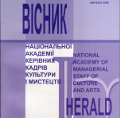СЕМАНТИКА НАГОТИ В МОДНІЙ ФОТОГРАФІЇ КІНЦЯ ХХ – ПЕРШОЇ ЧВЕРТІ ХХІ СТОЛІТТЯ
Semantics of Nudity in Fashion Photography of 20th Century
Author(s): Iryna SkorykSubject(s): Cultural history, Photography, Social history, Sociology of Culture, Sociology of Art, History of Art
Published by: Національна академія керівних кадрів культури і мистецтв
Keywords: fashion; fashion photography; corporeality; nudity; nakedness;
Summary/Abstract: The purpose of the article is to analyse the semiotics of the body in visual culture of the late 20th and early 21st centuries using the example of fashion photography; to find out how the body has turned from a passive screen for displaying socially and culturally significant markers into an active agent of shaping fashion trends. The research methodology is based on a combination of different approaches to describing the semantic nuances of the body image in modern fashion photography. In particular, with the help of the historical and genealogical method, the evolution of the narrative focus of fashion photography is shown, since at first attention was paid first of all to the beauty of the thing being sold, then to the idealised body. A structural approach was applied to analyse the multiple contexts of fashion photography, such as the perception of a material thing, its photographic representation and expert review. All of them are components of the fashion discourse. Using the epistemological method, the semantics of the concepts of nakedness (as acquired vulnerability) and nudity (as harmonious integrity) are distinguished. The scientific novelty of the study consists in revealing numerous semiotic contexts of the phenomenon of nudity in fashion photography, which is always aestheticised compositionally, colouristically, and cosmetically depending on the cultural environment and cultural era, and therefore naked physicality is a discursive phenomenon, like fashion in general. Conclusions. Corporeality in fashion photography of the 20th century expresses the incessant processuality of postmodern semiosis – the recoding of the world of things into the dimension of signs. The human body becomes a screen for the projection of these signs, the principle of an ongoing game, the eternal engine of advertising discourse to multiplicate visual images. The devaluation of things in the European culture of mass consumption of the second half of the 20th century, caused by their overproduction, contributed to a change in the critical focus of fashion from the clothes in which the human body is wrapped to the body itself. Elitism is no longer defined as a set of precious or luxurious things that a person desires to own and that require a financial investment. Instead, the signifier of exclusivity in late modern Western society is a healthy and attractive body. It requires competent care, medicalisation, sports training, and, therefore, in addition to financial, also investments of time and knowledge. Thus, the fashion photography of the end of the 20th – the first quarter of the 21st century shows the shift in the focus of the fashion discourse from the aesthetics of things to the aesthetics of lifestyle and self-creation, for which the human body serves as a screen.
Journal: Вісник Національної академії керівних кадрів культури і мистецтв
- Issue Year: 2023
- Issue No: 1
- Page Range: 127-131
- Page Count: 5
- Language: Ukrainian

